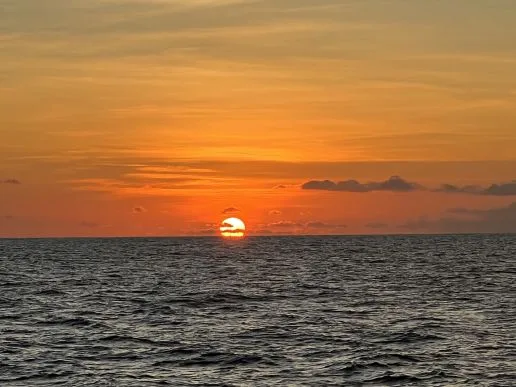Programs Blog
Golly! Being at sea is beautiful!

Vanessa Van Deusen, A Watch, 3rd Assistant Scientist
Ship’s Log
Noon Position
12 10.7′ S x 143 58.6′ W
Ship Heading
053 degrees
Ship Speed
6.5 kts
Taffrail Log
650 nm
Weather / Wind / Sail Plan
Mostly clear sky with some cumulus clouds, wind ESE, motorsailing under the four lower sails
Description of location
Central South Pacific
Golly! Being at sea is beautiful.
Afternoon watch yesterday started with a sunset filled with reds, oranges, and pinks. As the sun set, staff and students sat on the quarterdeck quietly taking in the colors. Some sat drawing, others journaling, and others quietly taking in the beauty of the South Pacific. Some birds flew past our ship, and one stopped to perch in the rigging-also looking back at the setting sun.
A beautiful sunset quickly turned into a clear moonless night. The stars came out while we were cleaning the galley, and after hauling the floor mats up on to deck to wash, I looked up and was struck by a sky filled with stars. The whole milky way was visible. No light pollution is a blessing that comes with being at sea. As if someone held a mirror up to the sky– the waves were flecked with bright blue bioluminescence-a sky of stars above and a sea of stars below. After galley cleanup but before setting up for a neuston net deployment, I spent 10 minutes standing alone on deck looking at the stars. Three shooting stars made an appearance! Golly! Being at sea is beautiful.
The bioluminescence was highlighted with the neuston in the water-with phytoplankton lighting up in response to being jostled by the net. Hauling up the neuston hand over hand I felt a sharp sting, a familiar zap from my time bothering anemones while working in seagrass beds. A quick look in our gelatinous slop of organisms caught during our tow revealed the culprit: a Portuguese Man’o War! Though it looks like a jellyfish, the Portuguese Man’o War is actually a colony of siphonophores floating on the surface. Some vinegar quickly remedied the stinging-and I was quickly back to marveling at the oddities in the net. We caught a large phylosoma-a larval lobster of that is translucent and angular. How a phylosoma metamorphoses into an adult lobster is a mystery on par with a caterpillar’s transformation into a butterfly in my eyes. The neuston net reveals a whole world of wonder filled with tiny aliens, perfectly adapted to surviving at sea. Golly! Being at sea is beautiful.
Vanessa Van Deusen, A Watch, 3rd Assistant Scientist
Recent Posts from the Ships
- Ocean Classroom 2024-A collaborative high school program with Proctor Academy
- Collaborations and Long-term Commitments: SEA’s Caribbean Reef Program Sets a Course for Coastal Programs that Compliment Shipboard Experiences.
- Sea Education Association students prepare for life underway using state of the art nautical simulation from Wartsila Corporation.
- SEA Writer 2022, Magazines From the Summer SEA Quest Students
- Technology@SEA: Upgrades Allow Insight into Ocean Depths
Programs
- Gap Year
- Ocean Exploration
- High School
- Science at SEA
- SEA Expedition
- SEAScape
- Pre-College
- Proctor Ocean Classroom
- Protecting the Phoenix Islands
- SPICE
- Stanford@SEA
- Undergraduate
- Climate and Society
- Climate Change and Coastal Resilience
- Coral Reef Conservation
- Marine Biodiversity and Conservation
- MBL
- Ocean Exploration: Plastics
- Ocean Policy: Marine Protected Areas
- Oceans and Climate
- Pacific Reef Expedition
- The Global Ocean: Hawai'i
- The Global Ocean: New Zealand